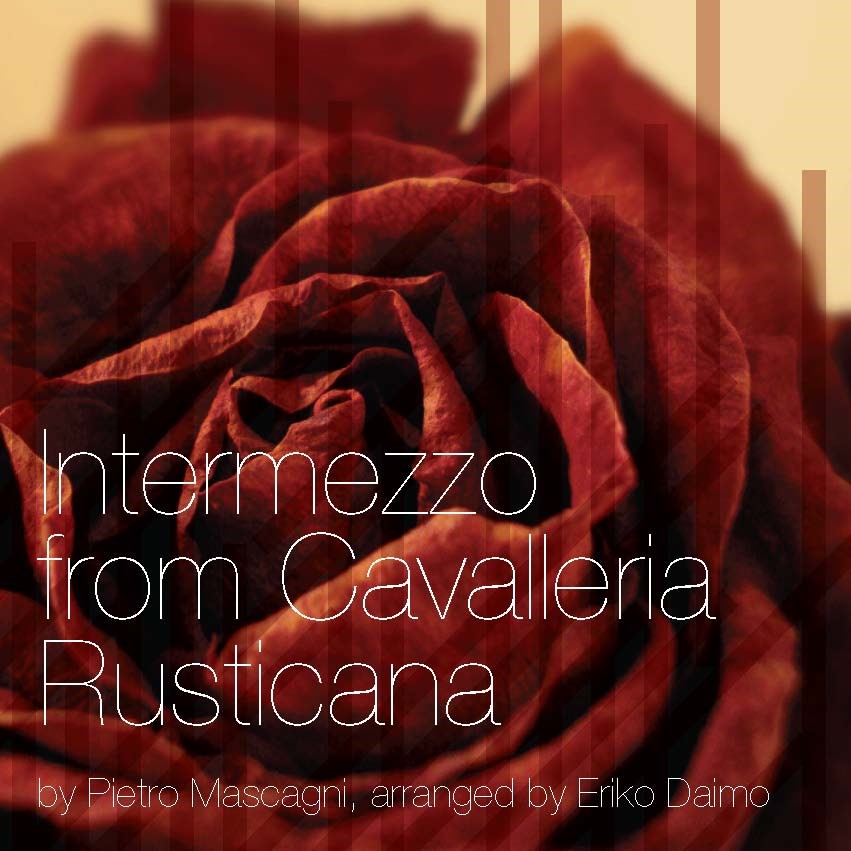
Cavalleria Rusticana (Intermezzo)
Composer: Pietro Mascagni
Instrument: Marimba
Level: Intermediate
Published: 2011
Price: €14.00
Item details
-
Description +
-
Duration: 5 min.
"That instrument makes a huge, warm sound, and the demeanour and virtuosity of soloist Eriko Daimo made this a performance to remember. Watching and hearing the four mallets play slow-moving, long-line, four-part harmony was extraordinary. No recording could capture that mesmerising combination of sound and sight."マリンバから深く温かな音が奏でられ、卓越したソリスト大茂絵里子の感性と妙技が、観る者にとって脳裏に焼き付けられる忘れられない演奏となった。4本のマレットで、4部のハーモニーを美しく長いフレーズでたっぷり奏であげるのを目の当たりにして、実に桁違いの演奏である事を痛感した。生演奏であるからこそ、視覚的にも聴覚的にも双方向から訴えかけてくる絶妙なバランスを表現しており、録音物では絶対に捉え切ることは出来ない体験だ。
Martin Adams, editor
The Irish Times (March 2015)
-
-
Instrumentation +
-
Marimba (5-octave)
-
-
Watch+
-
About the composer +
-
Pietro Mascagni (1863-1945) is one of the most important Italian composers of the turn of the 20th century. The formidable success of his first masterpiece in 1890, Cavalleria Rusticana, unfortunately eluded many of his following works. Mascagni however wrote 15 operas, an operetta, several beautiful orchestral and vocal works, as well as songs and piano music. He enjoyed amazing operatic successes during his lifetime, and at the same time pursued a very successful career of conductor. Mascagni's approach to opera differed a lot from that of his friend and rival Puccini, which arguably was one of the factors that led to an under-appreciation of the value of his music by critics.
-
-
Reviews +
-
Review (Percussive Notes, July (60) 2012)
In this beautiful composition elegantly arranged for marimba, Eriko Daimo has skillfully retained the loveliness of this opera intermezzo in a solo work.
Approximately five minutes in length, this two-page chorale spans nearly four octaves, but hovers primarily in the rich middle to lower range of the instrument. Although it is almost entirely rolled, Daimo includes a handful of struck chords, decorative single-line figures, grace notes, and piano rolls to provide some variety within the texture. Independent one-handed rolls are required in three instances in the right hand, but otherwise, all rolls could be performed as hand-to-hand or sequenced, depending on the performer’s preference. The original work makes use of a gradually increasing chordal texture in several places, featuring contrary motion in outer lines as inner voices are added. This is scored very effectively and, again, creates variety in texture during parts of the chorale.
There are limited dynamic markings and no tempo variations notated, but several phrases are marked with expressive terminology, and these indications should give the performer both permission and the expectation to add appropriate phrasing and shaping. Because of the beauty of the original intermezzo and the skillful care in the transcription, this new chorale for solo marimba is certain to be a popular addition to recitals and professional performances.—Josh Gottry
-
-
Credits +
-
Front Cover layout: Sune Kliborg Lynge (Kliborg Design)
Engraving: Eriko Daimo & Johan Svitzer
Photo: Ryusei Kojima
Printed in Copenhagen, Denmark
www.editionsvitzer.com
-

